It’s not all about pretty pictures–when and where a bug was recorded is a big part of the information being captured as the image itself. That’s because the site “helps expand on the natural histories” of its subjects, it says. “By capturing the place and time that submitted images were taken,” it explains, “we are creating a virtual collection that helps define where and when things might be found.”I would have felt welcome enough after Maury‘s hello, but then pretty quickly things got even friendlier. A previously anonymous recent arachnid visitor of mine—a colorful spider that was the second photo I uploaded (the one above)—got identified by BugGuiders with relative certainty asa Shamrock Orbweaver.“Maybe Araneus trifolium? Let’s see what the others think,” Contributing Editor Laura said, in the notes that suddenly appeared below my image.“I’m pretty sure this is A. trifolium,” concurred Contributing Editor Kryontf.Love it.
Pests & diseases Ideas, Tips & Guides
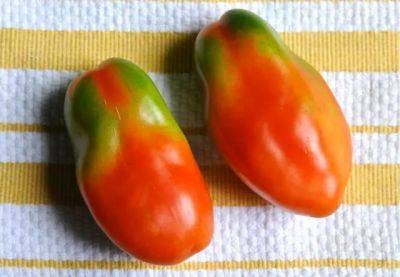
First ‘ripe’ tomatoes: uh-oh, green shoulders!
The fruits above (which are ‘San Marzano 2’) got exposed to too much heat and sun while ripening, which caused the chlorophyll up toward the stem end to fail to break down and give way to other pigments. Again, apparently some varieties are more inclined to have this issue surface under such stress than others that are more resistant; I have read that heirlooms are more inclined to green shoulders than hybrids, but who knows if that is so? Sometimes the color shifts to yellow (called yellow shoulders, of course)–but even then, not to red.The good news is that assuming subsequent fruits don’t get roasted and toasted on the vine, they’ll be fine. These two were on the lower part of the plant where some foliage had dried and dropped off, leaving them out in the altogether during the recent heatwave. If the plants had lost foliage where other fruit are forming, leaving them vulnerable, too, I’d provide some shade with a knitted fabric, forming a loose tent to block maybe 30 percent
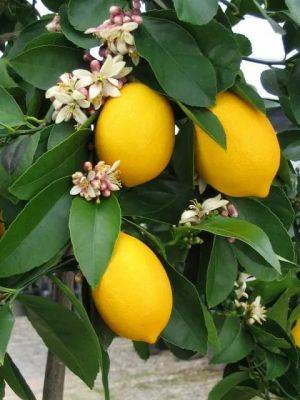
Citrus in pots: how to grow, and overwinter it, with four winds growers
Four Winds Growers was founded around the idea of developing and promoting dwarf varieties of citrus to fit the scale of the new-home boom in post-war California and beyond–including on all those patios, and also in pots as the container-gardening trend began to take hold. Four Winds remains a family business, and a multi-generational one. It was taken over by the founder’s son, who ran it from the early 1950s until recently, when his son took charge, along with his daughter; her husband, and a grandson.In his own home garden, Four Winds marketing director Ed Laivo has potted citrus that he has been growing for “upwards of 25 or even 30 years.” He joined me on the radio and podcast to share his tips on container growing and pest control. (The transcript of the Nov. 3, 2014 show is below.)citrus-growing q&a with e
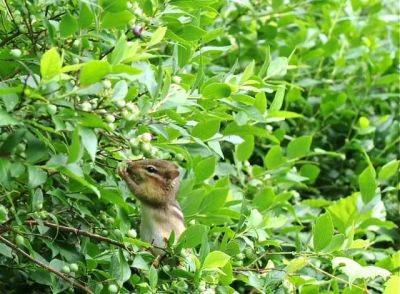
Early customers at my pick-your-own farm
APPARENTLY I AM OPERATING A PICK-YOUR-OWN blueberry farm, but my customers arrive early, before the fruit is even ripe; skip the baskets altogether, and leave without paying.
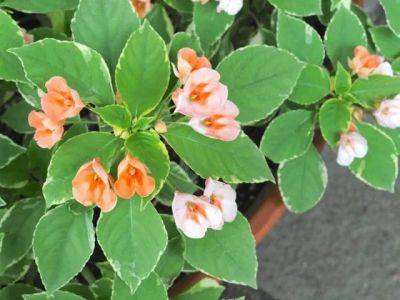
Impatiens downy mildew forecast: too soon to tell
First, a recap of what Impatiens downy mildew (the fungus-like Plasmopara obducens) looks like:Did your impatiens seem to collapse in 2012? Early signs of infection may have been leaves that looked yellowish, as if the plant needed feeding, or foliage that curled under or seemed to wilt. Sometimes, a white material (the downy mildew) is visible on the undersides of leaves. Eventually, plants may defoliate, drop their flowers, and basically collapse. The fungus loves moist conditions and cool nights in particular. Particularly disturbing: symptoms happened earlier last year than before—as early as June.The disease, which attacks Impatiens walleriana (the species our
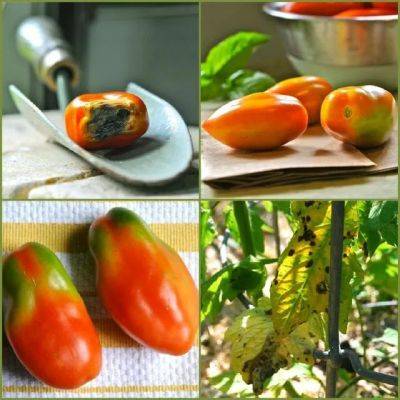
How are your tomatoes? diagnosing troubles
I CAN’T SEEM TO KEEP MY TOMATOES (or anything else) well watered enough in this dry year, and am expecting some kind of havoc as a result. Extended 90-degree daytime temperatures have already caused some flowers to drop before producing, for instance.
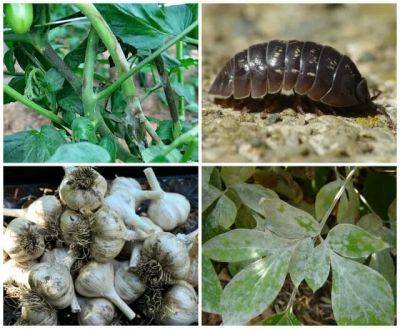
Powdery mildew, sowbug and pillbug infestation, fungicides on tomatoes, garlic bloat nematode: q&a with ken druse
In Part 1 (a transcript of which is at this link) we talked with a caller curious about the wonderful tree called Stewartia and how to make it happy—plus Ken recommended other garden-sized, multi-season trees to consider adding to your landscape, including dogwoods, redbuds, and tree lilacs.Ken, of Ken Druse dot com, is a longtime garden writer, author and photographer and all-around great gardener—and great friend. If you have a question for a future show, you can submit it in the comments on either of our websites, or use the contact form to send us an email from either site, or ask us on my Facebook page.Read along as you listen to the July 10, 2107 edition of my public-radio sho
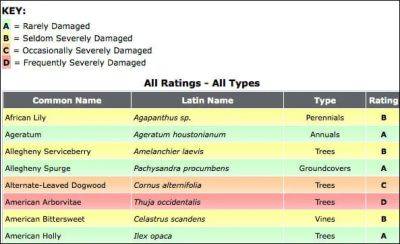
Podcast: gardening against the deer
THE BANG-BANG SOUND FROM THE WOODS this time of year—it’s hunting season!—always reminds me of who isn’t welcome in my garden, thanks to a tall fence. Keeping deer out, or choosing plants that are somewhat less palatable for the areas where you cannot bar them, was the topic of this week’s podcast.

The unholy holey garden: tackling slugs
I WAS ALMOST RELIEVED TO HEAR FROM a longtime reader that his Geranium macrorrhizum looked like some kind of lace–“shot through with tiny holes,” and that “this has never happened before.” Me too, and me either. Hostas, yes, and so many other things–but the trouble-free, aromatic, tough-as-nails bigroot geranium? All I can say is: 2012 is host to some fierce breed of slugs–and thanks to another reader, I have also found cabbage looper caterpillars‘ excrement (ahem!) in the geraniums, alongside the slime trails.

A new creature on me: the amazing nematomorph
“Something odd has to happen for hairworms to be on soil or vegetation, instead of in water, so at first when I got those calls I thought: It must be earthworms,” says Hanelt, a Research Assistant Professor with the Center for Evolutionary and Theoretical Immunology in the Department of Biology at the University of New Mexico in Albuquerque. “But I asked one caller to send me some—and lo and behold, they were hairworms.”It took years between the time Hanelt saw his first nematomorph, while on a survival-training hike in high school, until he actually knew what it was.“There they were out in the middle of the forest in winter, in a bucket of water,” he recalls. He saved the strange animal,
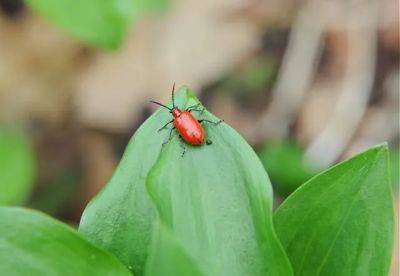
Fighting lily leaf beetles organically
Much in the same way I deal with everything from tomato hornworms to adult Japanese beetles to Viburnum leaf beetle and tent caterpillars and even the occasional slug in a wet year, my approach to lily beetles is manual–as in pick and squish, or drown.You have to get the adults, and also the eggs, which start out tan and then go from orange to red when they are close to hatching. They can be found wherever there are copulating adults (which is anywhere that adult beetles are, it seems from their flagrant behavior), on the undersides of leaves in uneven lines like a bit of a tiny zig-zag. Squish!Since the beetles overwinter in the soil, the minute lily or fritillaria foliage emerges, there are hungry beetles to damage it, too–meaning if they’re in your area, you probably are already seeing holes. Even if you didn’t get started right away, beg
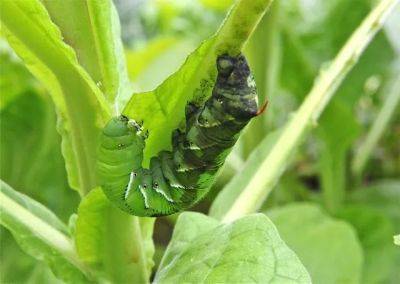
Is that a tobacco, or tomato, hornworm?
The tomato hornworm and tobacco hornworm both have angled white markings on their sides, but the tobacco hornworm’s seven marks just go in one direction, and the white is edged in black; the tomato hornworm’s eight marks per side are each more like a chevron, or “V,” with no black edge. The other big difference: Tobacco hornworms’ “horns” (which look like a tail) are usually reddish; the tomato hornworms’ are black or blue-black. (Oddly, I don’t have a photo of the tomato hornworm, but you can compare them on this University of Florida web page.)That University of Florida Entomology site has photos of the very similar-looking sphinx moths that each one becomes, too.I think the one just above was more recently “hatched,” because its body was still dark-colored, but I’m not certain. Maybe he’d just been smoking and got all sooty? (Kidding.) You can see all the life phases–caterpillar, chrysalis, sphinx moth–here.I have to say, I’m violent when one of these guys is eating my tomatoes in early summer, and it’s all “off with their heads” over here then. But in fall, as the garden un
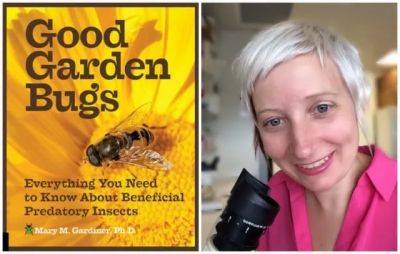
Cultivating ‘good garden bugs,’ with dr. mary gardiner
Here’s the wrinkle, though: Most of us probably don’t know which ones those are, and in fact have misconceptions about who’s who–often deeply ingrained by fear or a visceral sense of creepiness about insects.In her new book “Good Garden Bugs: Everything You Need to Know About Beneficial Predatory Insects,” Mary Gardiner (above and below) introduces us to a world of garden helpers, and she joined me on my public-radio show and podcast to do just that.Read along as you listen to the June 29, 2015 edition of my public-radio show and podcast using the player below. You

Evaluating native plants at mt. cuba center, with george coombs
In the early 1990s, when I was working on a book called “The Natural Habitat Garden” with my friend Ken Druse, we traveled the country interviewing native-plant enthusiasts and photographing their gardens. One memorable stop was the home of Mrs. Lammot du Pont Copeland, outside Wilmington, which today is the botanic garden called Mt. Cuba Center, with more than 50 acres of display gardens on more than 500 acres of natural land.I’d never seen native terrestrial orchids before, or the vivid red and yellow wildflower called Spigelia marilandica anywhere, and that day I learned that some discerning and forward-thinking experts such as Mt. Cuba’s first horticulture director, the great Dick Lighty, were already busy selecting “better” forms of native plants for garden use–a trend that has accelerated and become one of the hottest areas of contemp
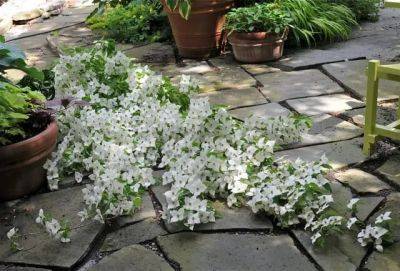
A fallen kousa branch (and no vase big enough)
THE ONLY THING THAT WOULD HAVE MADE THIS MISHAP a little more bearable: if I’d had a vase big enough for the spectacular flower-covered branch I lost to storms from one of my Cornus kousa, or Korean dogwoods, last week. Come to think of it, I don’t even have ceilings tall enough to accommodate the 11-foot consolation prize indoors, vase or no vase.

Working around wet spring soil (and self-sowns), plus mole and vole issues: q&a with ken druse
My longtime friend Ken, an award-winning garden photographer and author of many books, including “The New Shade Garden” and “Making More Plants,” produced his own “Real Dirt” podcast for 10 years, all available on KenDruse dot com.Read along as you listen to the May 15, 2017 edition of the program using the player below (or at this link). The May show is a doubleheader, and includes a whole “overtime” segment (starting at about 24 minutes into the audio file), which I’ve separated into its own transcript and is at this link (and includes questions and answers on what to do next, after you pull or dig invasives like garlic m
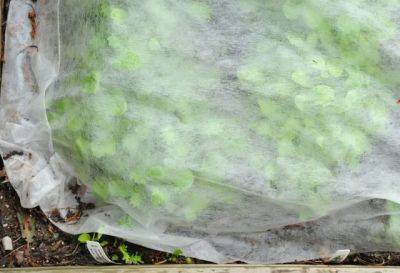
Growing under cover: tips from paul gallione
Gallione, in his position as Technical Services Technician in the research department at Johnny’s Selected Seeds in Maine, is used to answering gardeners’ questions. I started at the beginning with mine: Why grow crops under cover, anyhow?There are two basic uses for fabric row covers, Paul explained:To modify temperature (for heat retention or frost protection, most early and late in the season with heavyweight fabrics); As a barrier to keep out insects, crows, and chipmunks, to name a few common troublemakers. (Note: You can also create some shade, perhaps for summer salads—t
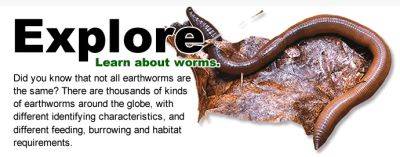
Earthworm 101, with great lakes worm watch
First, some background: Great Lakes Worm Watch is a citizen-science outreach organization, working to map the state of the earthworms—and the habitats they’re living in.“We want to know where earthworms are across the landscape,” says Ryan—and that means even beyond the Great Lakes area, where the project began. (There is a Canada Worm Watch, too, for those across the border; researchers at the University of Vermont, at the Cary Institute in Millbrook, New York, and elsewhere are likewise studying earthworm invasion.)Individuals, schools or garden groups can sign on help collect data on what worms are fou

Feed the soil: my experiment with mycorrhizae
The tipping point had been meeting Graham and Layla Phillips, who had recently taken over Bio-Organics, founded in 1996 and one of the first companies to commercialize mycorrhizal agricultural products (disclosure: they have advertised on A Way to Garden). We got to talking, and I pestered them with my usual endless questions–and then bought myself that jar of a blend of viable beneficial organisms from their online store.I didn’t just take their word for how it all worked, however; I dug deeper. Extensive Texas A&M research over more than 25 years reports that the benefits of mycorrhizae include plants that are more vigorous, with increased drought and disease resistance and the ability take up more nutrients and water. They may also need less pesticides because of their overall better response to stress. (Mycorrhizae have even been used by Aggie researchers on Texas lignite coal-industry land to try to revitalize it after mining, but I’m hoping your garden isn’t in that condition!)Even deeper background: Mycorrhizae weren’t
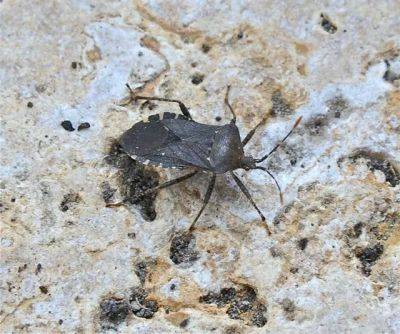
Fall pest patrol: work now to foil deer, cabbage worms, viburnum beetle, squash bugs, voles
THE MOST IMPORTANT SUBSET of the fall garden cleanup chores: pest control. Fortunately all our needed cutbacks and raking of leaves–those sanitation efforts we’re all heading out to do, anyhow—help to reduce places for many garden pests to overwinter.
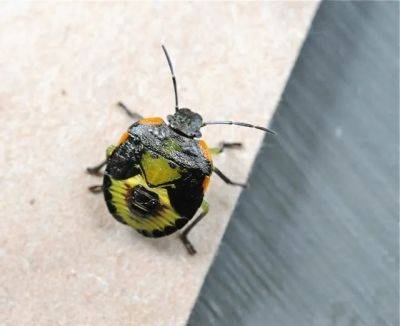
Garden bugs i have known: knowledge is power
I LOVE THAT the species name for this bug, hilare or hilaris, means cheerful or lively, and indeed its nymph stage (top photo) is colorful as a clown. The adults are bright green and shield-shaped. With its sharp, piercing mouthparts, the green soldier or stink bug is good at eating most anything plant-wise, but really enjoys black cherry, flowering dogwood, pine, highbush blueberries, apples, eggplants, tomatoes and much more. A more complete list of the green stink bug’s diet and a look at its life-cycle. They can damage soybean crops, and out West, Acrosternumis a pest of almonds.squash bug, Anasa tristisIF THE GREEN SOLDIER BUG’S name is cheerful, the most common squash bug’s, Anasa tristis, says it is sad–which is what it was making me when I was picking these guys off regularly earlier this summer. How to prevent and eliminate squash bugs.three-lined potato beetle,Lema daturaphila or trilineaWHEN I FIRST SAW THESE on my potato foliage in late spring, I thought

Squash bugs and other squash problems, with diane alston of utah state
Diane, who creates the popular “Bug Bytes” segments on Utah Public Radio’s garden show and serves as the Utah Extension’s Integrated Pest Management Coordinator, joined me on the radio and podcast. It included tactics for preventing and controlling diseases and insect pests of squash—and how a gardener’s toolbox that includes resistant seed varieties, Reemay fabric, kaolin clay, and even a roll of duct tape can help you succeed. (Above, a squash big adult, Anasa tristis; Wikipedia photo by Ilona Loser.)Read along as you listen to the March 16, 2015 edition of my public-radio show and podcast using the player below. You can subscribe to all future editions on iTunes or Stitcher (and browse my archive of podcasts here). (A companion story on growing cucurbits step-by-step, is at this link, to complete the package.)listen/read: squash success, with utah

Links i liked: fighting impatiens disease, crossbill irruption, overwintering ticks
THE DISEASE THAT DETHRONED Impatiens as the top annual in the nursery industry—Impatiens Downy Mildew—continues to take its toll. But a breakthrough reminiscent of advancements we hear about in medical research was announced this month by industry giant Ball Horticultural Company.

Downy mildew: don't compost sickly impatiens
AllImpatiens walleriana types are potentially affected. That’s the species that the common garden impatiens is bred from, as are the double-flowered types and miniatures and the Fusion series I like so much (that’s variegated Fusion Peach Frost, above). Other impatiens species may likewise be susceptible–even the native jewelweed, Impatiens capensis.The updated Impatiens Downy Mildew factsheet from Cornell Cooperative Extension explains that early signs of infection may have been leaves that looked yellowish, as if the plant needed feeding, or foliage that curled under or seemed to wilt. Sometimes, you can see a white material (the fungus) on the undersides of leaves. Eventually, plants may defoliate, drop their flowers, and basically collapse. The American Floral Endowment website has detailed photos of symptomatic plants, and other links (most geared to growers) about this threat to a favorite bedding plant.Categoriesannuals & perennials compo

A botanical whodunit: r.i.p., yellow magnolia
I’ve always thought of this particular magnolia as perhaps a bit too energetic, and somewhat unrefined. It shot up fast a decade or so ago when I planted it, and never seemed to stop, assuming an ever-widening domain for itself. One of its parents is the very-fast-growing cucumber tree magnolia, Magnolia acuminata, so probably no surprise; the other parent, M. denudata, is no slowpoke, either.At the time of its death, the tree was more than 20 feet tall and about 15 feet wide, with no signs of stopping. Or so I thought.About three weeks ago, the flowers on one lower and one upper branch opened on schedule—but not the rest. The tree had positively covered itself in flower buds last year, holding countless furry silver beauties all winter long. (Maybe I should have been suspicious: It had produced many more buds than

2015 resolution: become a more thoughtful organic gardener, with jeff gillman
A candid head’s up: Like Jeff, I am less-than-enthusiastic about the seemingly widespread desire among gardeners to shop their way out of issues with pests, disease, or soil imbalances. I buy a lot of seeds and bulbs and plants–but not a lot of “stuff.”Jeff and I had a funny email exchange, when I invited him to join me on the radio show and podcast, and asked about what topics he’d most like to cover together.“The topics that I speak on most frequently are garden remedies and thoughtful organic gardening,” Jeff replied. When I read that, my slightly dark humor zoomed in on the phrase “thoughtful organic gardening.”Except I thought he said, “thoughtless organic gardening.” I g

Build a better melon, cuke, squash? cucurbit downy mildew research at twin oaks seed farm
All growing season, I get questions asking how to prevent, or cure, one vegetable garden disease or pest or another–especially on Cucurbits. My answers are mostly not perfect ones, because almost faster than we figure out some effective tactic, plant diseases can outsmart us by mutating, or getting an edge from dramatically changing weather patterns–or by moving into regions where they were not previously known.So what can be done, longterm, beyond trying to “fix” the one outbreak in just your, or my, backyard, and especially: What’s the bigger answer without turning to chemicals?The answer hopefully lies in research: research that identifies the best current varieties, and often leads to breeding of more disease-resistant and regionally adapted var
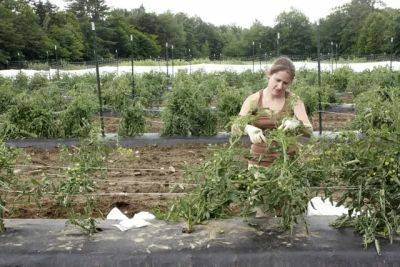
Grow healthy tomatoes: staking and pruning
Staked plants will ripen faster crops of generally larger fruit. Stakes must be at least 1 inch thick and 6 feet high, inserted a foot into the ground. Adding supporting twine between stakes (as in the photo above) helps add stability; some gardeners lash horizontal cross-pieces of bamboo between stakes instead. Either way, as the plant grows you continue to tie it to the support with twine or twist-ties.Remember: Staked plants require a commitment to ongoing pruning, keeping the plant to one or two main stems of vine-like, not bush, habit. All small suckers that develop in the crotches between the leaves and the main stem must be removed.good ‘tomato hygiene’WHAT’S MOST APPEALING to me is that staking can help with disease prevention, which actually begins with selecting an appropriately disease-resistant variety (Cornell has a list of what variety resists what).Certain fungal pathogens, such as septor
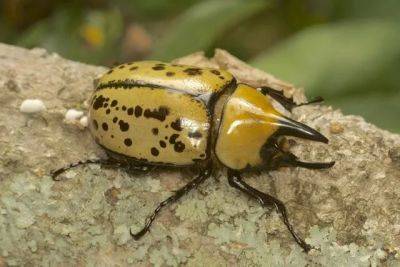
Giveaway: the wide world of beetles, with dr. arthur evans
Working primarily as an independent researcher, Art Evans is a research associate at the Smithsonian Institution, Virginia Natural History Museum, and Virginia Commonwealth University (VCU). He is also an adjunct professor at VCU, University of Richmond, and Randolph-Macon College, and creates a weekly radio spot called “What’s Bugging You” on Richmond Public Radio, along with a popular Facebook page about–you guessed it–insects!Though a massive guide to beetles like “Beetles of Eastern North America” might sound like it’s not for you, it is.“Even though I hope my colleagues will enjoy and appreciate the book,” says Art Evans, “they were not my primary audience. My primary audience were people like yourself, who may appreciate nature but may not have taken the time to look and see what beetles are living amongst them.”On his recent return from a trip working on the next volume—a Western edition—Art Evans was the guest on my Augus

Deer-resistant plants, with broken arrow’s adam wheeler
As Propagation and Plant Development Manager at Broken Arrow Nursery in Connecticut, Adam Wheeler has to know which ones have built-in deer resistance, because most customers aren’t living behind 8-foot protection (which by the way, doesn’t deter woodchucks and rabbits, so I am not off the pest-control hook).I called Adam for advice about a hugely popular subject that he calls:Read along as you listen to the May 30, 2016 edition of my public-radio show and podcast using the player below, and learn about some of Adam’s favorite conifers, small trees,

The tick-borne disease equation, with dr. rick ostfeld of cary institute
Longtime disease ecologist Dr. Richard Ostfeld of Cary Institute of Ecosystem Studies took me through the complex system of animal interactions, the effects of a warming climate, and other factors in the tick-borne disease equation, including advice on when and how to be alert.Admittedly, most of the pests readers ask me about are ones that feast on plants, but this one is not phytophagous but rather hematophagous, feasting on blood:“Ticks: the foulest and nastiest creatures that be.”So said Pliny the Elder, the Roman scholar who wrote a massive na

What garden ‘pests’ are trying to tell us, from eliot coleman’s ‘the new organic grower’
Eliot Coleman has written extensively about organic agriculture since 1975. He has more than 50 years’ experience in all aspects of the subject and has been a commercial market gardener, the director of research projects, a designer of tools for farmers and gardeners, and a teacher and lecturer. He and his wife, Barbara Damrosch, operate Four Season Farm, a commercial year-round market garden in Maine.Read along as you listen to the Oct. 8, 2018 edition of my public-radio show and podcast using the player below. You can subscribe to all future editions on iTunes or Stitcher (and browse my archive of podcasts here).Learn why he invokes us to “cultivate ease and order, not battle disease and disorder,” and more—plus enter to win the revised edition of “The New Organic Grower: A Master’s Manual
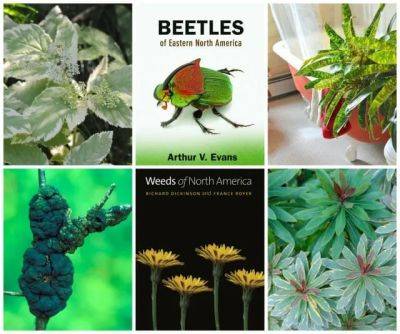
When variegation reverts, killing goutweed, cucumber wilt, black knot fungus: q&a with ken druse
Ken, an award-winning garden photographer and author of more books than I can count, including “The New Shade Garden” and “Making More Plants,” produced his own “Real Dirt” podcast for 10 years, all available on KenDruse dot com (and still available on iTunes, too).Read along as you listen to the Sept. 4, 2107 edition of my public-radio show and podcast using the player below. You can subscribe to all future editions on iTunes or Stitcher (and browse my archive of podcasts here). Want to just browse past Q&A shows with Ken and me? They’re at this link.the september urgent garden question q&awhen to take in the houseplants?Q. So I’ll get right to the point: I’m thinking about those houseplants, because
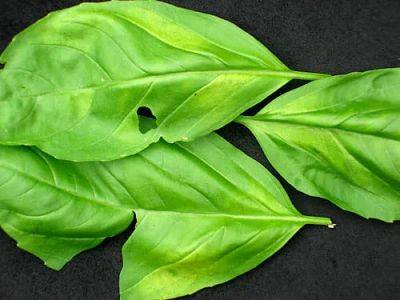
Calling all gardeners: report basil downy mildew occurrences!
“Their reports have helped me a lot in my work to understand where this disease is occurring, and what conditions are most favorable,” she says. “But we scientists always want more information! I am especially interested to hear from gardeners in states where I have gotten few or no reports.”So gardeners: Is your basil in trouble? The tipoff: The plants look pekid, the tops of its leaves marked with diffuse yellow (top photo, as infection begins), as if hungry for fertilizer, but then going brown. Turning them over reveals distinctive vein-bounded brown or fuzzy gray patches (starting in photo below). The decline continues; leaves drop.Plant pathologists including Meg, plants breeders

Do home remedies for weeds or garden pests work? ask jeff gillman
I’m a longtime organic gardener, meaning no lover of chemical “answers” to problems, but I’m also no lover of the endless and often-wacky home remedies that I read about year after year.Some home remedies do work, but some are not just ineffective, but also dangerous, sometimes as dangerous as chemicals.I was interested to read an open letter in summer 2015 to “Consumer Reports” written by Jeff, a former Associate Professor of Horticultural Science at University of Minnesota, who has a masters in entomology and PhD in horticulture, plus 20 years of practical and research experience with plants. He’s the author of “The Truth About

Discouraging deer in the garden, with ohio state’s marne titchenell
First an anecdote: A recent September weekend, during a workshop in my garden, one attendee commented as he looked around at all the mature shrubs and big swaths of perennials: “You must have a fence, because otherwise this garden wouldn’t be here,” he said. Because it’s mostly hidden in the surrounding woodland tree line, he hadn’t spied the fence itself yet, but he just knew: It’s a deer-free zone.A fence isn’t practical for every garden, but thankfully a range of other tactics are possible, from barriers that are less ambitious to erect, to repellents, to a smarter plant palette than I have and more. Marne shared various strategies in the October 10, 2016 edition of my public-radio show and podcast. Read along as you listen in, using the player belo
Popular Topics
Our site greengrove.cc offers you to spend great time reading Pests & diseases latest Tips & Guides. Enjoy scrolling Pests & diseases Tips & Guides to learn more. Stay tuned following daily updates of Pests & diseases hacks and apply them in your real life. Be sure, you won’t regret entering the site once, because here you will find a lot of useful Pests & diseases stuff that will help you a lot in your daily life! Check it out yourself!
